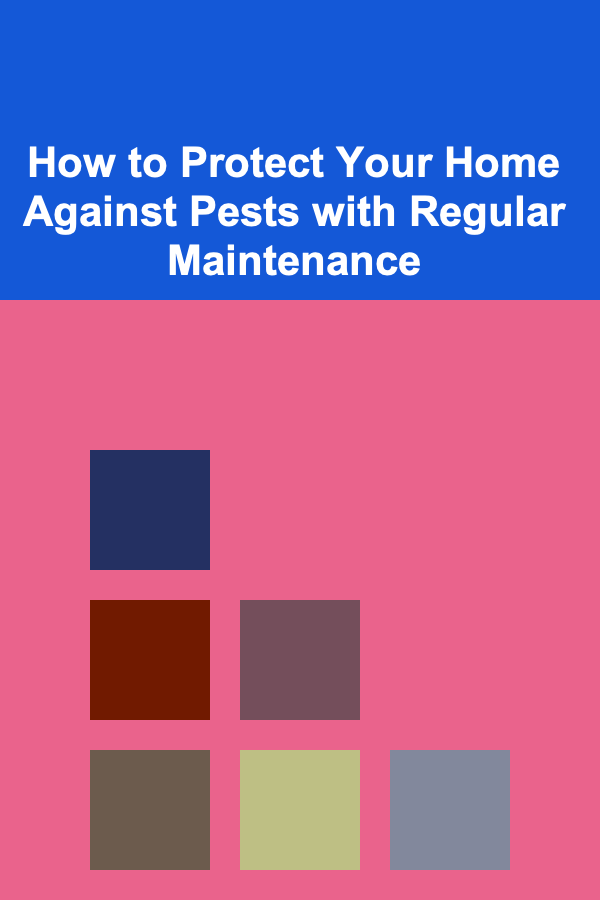
How to Protect Your Home Against Pests with Regular Maintenance
ebook include PDF & Audio bundle (Micro Guide)
$12.99$6.99
Limited Time Offer! Order within the next:

Pest control is a crucial aspect of home maintenance that often gets overlooked until it's too late. Whether it's termites silently eating away at your foundation or rodents sneaking into your attic, pests can cause serious damage to your home and pose health risks to your family. One of the most effective ways to prevent pest infestations is through regular maintenance. By staying vigilant and proactively maintaining your home, you can reduce the likelihood of attracting unwanted guests and avoid costly damage repairs.
This article will explore how regular home maintenance can help protect your home against pests, offering practical tips, preventive measures, and strategies to keep your home pest-free. From sealing entry points to maintaining a clean and dry environment, we'll cover everything you need to know to safeguard your home.
Understanding Common Household Pests
Before diving into preventive measures, it's important to understand the types of pests that commonly invade homes and the damage they can cause. Here are some of the most common household pests:
1. Termites
Termites are among the most destructive pests. These tiny insects feed on wood, cellulose, and other plant-based materials. While they don't bite humans, termites can silently and gradually weaken the structural integrity of your home, causing extensive damage. If left unchecked, termites can lead to costly repairs.
2. Rodents
Rodents, particularly rats and mice, are another significant concern for homeowners. They not only contaminate food but also cause structural damage by chewing through wires, insulation, and even wooden beams. Additionally, rodents can carry diseases like hantavirus, leptospirosis, and salmonella.
3. Ants
Ants are social insects that often invade homes in search of food and water. While most species are harmless, some, like carpenter ants, can damage wood, making them a particular concern. Other species, such as fire ants, can pose a risk due to their painful stings.
4. Cockroaches
Cockroaches are not only unsightly but also carry diseases. These pests thrive in warm, humid environments, such as kitchens and bathrooms. They can contaminate food, surfaces, and air with harmful bacteria.
5. Bedbugs
Bedbugs are notorious for their ability to hide in cracks and crevices, making them difficult to detect. They feed on human blood, leaving itchy bites. While they don't transmit diseases, their presence can cause significant discomfort and anxiety.
6. Spiders
While most spiders are harmless, some species, like the black widow or brown recluse, can pose a danger to humans with their venomous bites. Spiders typically enter homes in search of food, such as other insects, but they can also be a nuisance due to their webs.
7. Wasps and Bees
Wasps and bees can be aggressive if they feel threatened. A wasp nest near your home can be dangerous, especially for individuals who are allergic to stings. While bees are crucial for pollination, a nest on your property can cause problems if disturbed.
Understanding the types of pests that are common in your area will help you better prepare your home for prevention. Now, let's take a look at how regular maintenance can keep these pests at bay.
Regular Home Maintenance Tips to Prevent Pests
Effective pest control begins with prevention. Regular maintenance around your home is essential for keeping pests from finding shelter and food. Here are several key maintenance tasks that can help protect your home from pest invasions.
1. Seal Entry Points
Pests, especially rodents and insects, can enter your home through the smallest gaps and cracks. Sealing these entry points is one of the most effective ways to prevent pests from getting inside.
- Inspect Doors and Windows: Ensure that all doors and windows are properly sealed. Look for gaps or cracks in the frames and replace or re-caulk as needed. Install door sweeps and weather stripping to prevent pests from slipping through.
- Check Vents and Exhausts: Ensure that vents, chimneys, and exhaust fans are covered with mesh or screens to prevent pests from entering through these openings.
- Repair Cracks in the Foundation: Check the foundation of your home for any visible cracks. Even small openings in your home's foundation can provide easy access for insects and rodents. Seal cracks with concrete filler or mortar.
- Check for Gaps Around Pipes: Inspect pipes, cables, and wires entering the home. Use caulking or foam sealant to seal any gaps around these openings.
2. Maintain a Clean and Clutter-Free Home
A clean and organized home is less attractive to pests. Pests like rodents, ants, and cockroaches are often drawn to homes that have food scraps or clutter. Maintaining a clean living environment is one of the simplest and most effective ways to prevent infestations.
- Clean Food Spills Immediately: Always clean up crumbs, spills, and food waste promptly. Pests are drawn to food sources, and even small traces can attract them.
- Store Food Properly: Store food in airtight containers, especially pantry staples like grains, flour, and sugar. Don't leave food out on countertops overnight.
- Take Out the Trash Regularly: Empty your trash cans frequently, particularly in the kitchen. Make sure trash bins are tightly sealed, and consider using trash cans with tight-fitting lids to keep pests from accessing food scraps.
- Reduce Clutter: Pests love cluttered spaces where they can hide. Keep your home tidy, especially in areas like basements, attics, and closets, where pests are more likely to take shelter. Consider decluttering areas that tend to collect dust, debris, and food waste.
3. Maintain a Dry Environment
Many pests, such as termites, cockroaches, and mold, thrive in humid environments. Keeping your home dry is key to preventing infestations and minimizing the risk of damage to your home.
- Fix Leaks Promptly: Water leaks in walls, ceilings, and pipes can provide a perfect environment for pests like termites and mold. Make sure to repair any leaks promptly, and monitor your home for signs of water damage.
- Use Dehumidifiers: In areas prone to high humidity, such as basements and bathrooms, use dehumidifiers to reduce moisture levels and prevent the growth of mold and mildew.
- Ventilate Damp Areas: Make sure your home is well-ventilated, especially in areas like the kitchen, bathroom, and laundry room. Use exhaust fans to remove moisture from the air and prevent pests from taking advantage of the humid conditions.
- Inspect Gutters: Blocked gutters can lead to water damage around the foundation of your home. Clean gutters regularly to prevent water buildup and reduce the risk of pest infestations.
4. Landscaping and Outdoor Maintenance
The exterior of your home is just as important as the interior when it comes to pest prevention. Proper landscaping and outdoor maintenance can significantly reduce the chances of pests finding their way inside.
- Trim Vegetation Away from the House: Pests, including ants, spiders, and termites, can use trees, shrubs, and other vegetation to gain access to your home. Trim branches, vines, and plants that are touching the exterior of your house to prevent pests from using them as a bridge to enter.
- Keep Firewood Away from the Home: Firewood piles are a common hiding spot for pests like termites and rodents. Store firewood away from your home, at least 20 feet from the foundation, and off the ground to prevent pests from nesting in it.
- Remove Standing Water: Standing water around your property can attract pests like mosquitoes and rodents. Check your yard regularly for pools of water, particularly in areas like gutters, birdbaths, or areas where water tends to collect.
- Install Screens on Windows and Vents: Installing screens on open windows, vents, and chimneys can help keep insects and pests from entering your home. Make sure the screens are in good condition and don't have any holes or tears.
5. Regular Inspections
Performing regular inspections of both the interior and exterior of your home will help you spot potential issues before they become serious problems. This is especially important for pests that may cause hidden damage, such as termites or rodents.
- Inspect for Signs of Pests: Check for droppings, gnaw marks, webs, or nests around the home. If you notice any signs of pests, take action immediately before the infestation becomes larger.
- Check the Attic and Basement: These areas are prime spots for pests to hide, so inspect them regularly. Look for any signs of entry points, water damage, or pest activity.
- Call a Professional Pest Control Service: Even with regular maintenance, it's a good idea to schedule annual inspections with a professional pest control service. They can help identify potential issues that may not be immediately visible and offer guidance on how to address them.
6. Exterminate Invasive Pests
If you discover a pest problem, it's essential to act quickly. If the issue seems manageable, you can use over-the-counter pest control products. However, if the infestation is large or difficult to manage, it's best to call a professional pest control service to handle the problem.
- Use Traps and Baits: For rodents, traps and baits can be an effective way to catch and remove pests. Be sure to place traps in areas where rodents are most likely to travel, such as along walls or near entry points.
- Use Insecticides Safely: For insect infestations, you can use insecticides or repellents to eliminate pests. Always follow the manufacturer's instructions and use products that are safe for pets and children.
Conclusion
Protecting your home from pests requires a proactive approach to maintenance and cleanliness. By regularly inspecting your home, sealing entry points, maintaining a dry and clutter-free environment, and addressing any pest issues immediately, you can keep your home pest-free and protect it from damage. Regular maintenance not only helps prevent infestations but also creates a healthier and more comfortable living environment for you and your family. By staying vigilant and taking small preventive steps, you can ensure that your home remains safe from pests for years to come.
Reading More From Our Other Websites
- [Biking 101] The Ultimate Guide to Bike Races: Training, Strategy, and Equipment
- [Home Maintenance 101] How to Maintain Your Home's Security System for Optimal Protection
- [Home Security 101] How to Install and Use the Best Video Doorbell Camera for Real-Time Security
- [Home Space Saving 101] How to Save Space in Your Dining Area with Compact Furniture
- [Home Space Saving 101] How to Utilize Under Bed Storage for a Clutter-Free Bedroom
- [Home Security 101] How to Prepare Your Home for a Long Absence
- [Personal Investment 101] How to Sell Pre-Trained Deep Learning Models for Profit
- [Home Pet Care 101] How to Build a DIY Dog Agility Course at Home
- [Personal Financial Planning 101] How to Create a Budget That Actually Works: A Practical Approach
- [Home Lighting 101] How to Choose the Right Lighting Fixture Materials for Different Room Styles

How to Organize Virtual Extracurricular Activities
Read MoreHow to Set Up an Effective Campaign Tracking System
Read More
How to Style Your Home for the Holidays with a Minimalist Approach
Read More
How To Brew Coffee on a Camping Trip
Read More
Selecting the Best Oven Cleaning Brush for Baked-On Grime
Read More
10 Tips for Designing a Functional and Stylish Home Office During Renovation
Read MoreOther Products

How to Organize Virtual Extracurricular Activities
Read MoreHow to Set Up an Effective Campaign Tracking System
Read More
How to Style Your Home for the Holidays with a Minimalist Approach
Read More
How To Brew Coffee on a Camping Trip
Read More
Selecting the Best Oven Cleaning Brush for Baked-On Grime
Read More